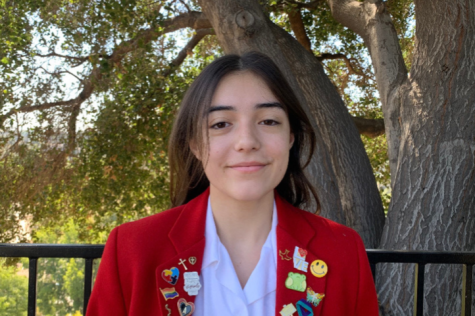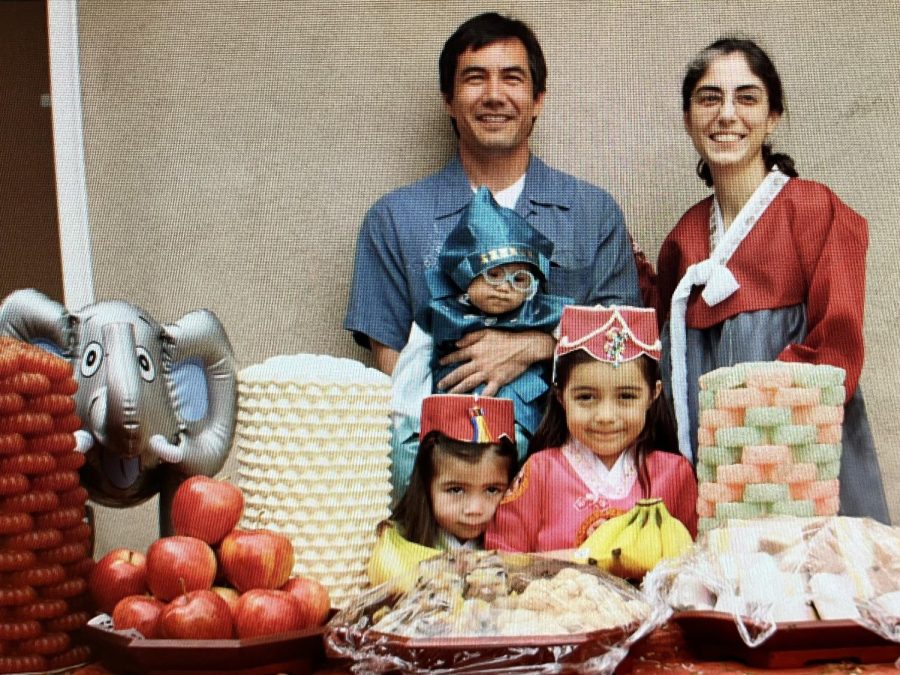Hyphenated heritage: what my multicultural identity means to me
Writer Sara Green smiles with her family in a pink hanbok in front of her brother’s banquet table during his traditional Korean birthday party.
When I was younger, I had a box of building blocks. The lid of the box had different shapes cut into it, where each respective block could be placed inside. Every day, I would empty the box out and sort the blocks through the lid, even if I didn’t play with the blocks themselves. I loved sorting them — the satisfaction of finding a block that perfectly matched its lid cut-out. However, I soon learned that nothing in life was as simple as that. Unlike my building blocks, some things just don’t seem to fit anywhere.
For the longest time, my cultural identity was one of those things — something that I wasn’t sure how to place. Everyone I knew could explain their identity in one word. I, on the other hand, couldn’t. While I knew that I spoke Spanish at my house and with my Grandma and Grandpa on my Mom’s side, I also knew that my dad’s side was Korean. When I went over to my Grandma’s house (my Halmoni), we would play the buk, a Korean drum, and dance to it together. We would also eat gimbap, a traditional Korean food, alongside other traditional Korean foods like mandu and kimchi. When I went over to my other grandparents’ house, however, I would eat frijoles and build puzzles with my Nana with a fuzzy-tiger-print-blanket wrapped around us (Mexican childhood staple, if you know you know).
As I grew older, this inability to determine my culture made me grow distant from it. Because I couldn’t place my background, or understand which “box” I fit into, I withdrew altogether. I ignored the annual celebrations of Dia De Los Muertos in my home and refused to wear my traditional Korean hanbok. I was hesitant to learn more about or connect with my culture because I didn’t understand what it was. How was I supposed to balance being Korean and Mexican? It felt like I was walking an uncharted path, one which I was completely unsure how to navigate.
As I have grown older, however, this embarrassment and hesitance to participate in my culture have decreased drastically. I think this is because as I have become more comfortable with myself, I have also become more comfortable with all different aspects of my identity. Now, instead of worrying about identifying as Mexican or Korean, I just try and navigate being Mexican and Korean. This has looked like many things in my life: making tamales with my tias and cousins at Thanksgiving and Christmas, learning traditional Mexican music on the guitar, and even attempting to learn Korean. While I know that these are all small things outwardly, to me they mean so much and have allowed me to feel like I don’t have to be ‘Mexican enough’ or ‘Korean enough’ to participate in my culture. I already am enough.
My mixed background is what makes me unique. Whereas when I was younger, being a mix of cultures no one had ever heard of was unsettling and uncomfortable, it is now something I’m extremely proud of. I don’t know anyone else who is Mexican and Korean, and therefore who has the same experiences I have had throughout my life thanks to my culture.
Throughout my experience with my identity, I have learned that things don’t always have to fit into boxes. In fact, the things that end up being the most influential and important are the things that are complex, beyond straight edges and rounded corners. Ultimately, I am thankful for who I am, and that includes my Mexican-Korean identity, with all of its hyphens and complexities.

Sara Green is the social media manager at the Veritas Shield and a senior on the Hill this year. She started working for the paper as a junior, and enjoys...


Kristen Anderson • Feb 26, 2023 at 10:47 am
Wonderful stories, thank you for sharing your Veritas with all of us! Beautiful family photo and how blessed to be from two culturally rich families and to be surrounded by so much love!
Jennifer King • Feb 24, 2023 at 1:53 pm
This is a beautiful reflection, Sara. “I already am enough.” Yes, you are.